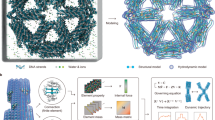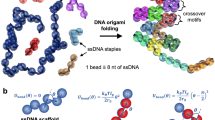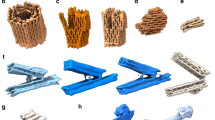Abstract
Self-repair is essential to all living systems, providing the ability to remain functional in spite of gradual damage. In the context of self-assembly of self-repairing synthetic biomolecular systems, recently Winfree developed a method for transforming a set of DNA tiles into its self-healing counterpart at the cost of increasing the lattice area by a factor of 25. The overall focus of this paper, however, is to develop compact designs for self-repairing tiling assemblies with reasonable constraints on crystal growth. Specifically, we use a special class of DNA tiling designs called reversible tiling which when carefully designed can provide inherent self-repairing capabilities to patterned DNA lattices. We further note that we can transform any irreversible computational DNA tile set to its reversible counterpart and hence improve the self-repairability of the computational lattice. But doing the transform with an optimal number of tiles, is still an open question.
Preview
Unable to display preview. Download preview PDF.
Similar content being viewed by others
References
Liu, D., Wang, M.S., Deng, Z.X., Walulu, R., Mao, C.D.: J. Am. Chem. Soc. 126, 2324–2325 (2004)
LaBean, T.H., Yan, H., Kopatsch, J., Liu, F., Winfree, E., Reif, J.H., Seeman, N.C.: The construction, analysis, ligation and self-assembly of DNA triple crossover complexes. J. Am. Chem. Soc. 122, 1848–1860 (2000)
Mao, C., Sun, W., Seeman, N.C.: J. Am. Chem. Soc. 121, 5437–5443 (1999)
Winfree, E., Liu, F., Wenzler, L.A., Seeman, N.C.: Design and self-assembly of two-dimensional DNA crystals. Nature 394(6693), 539–544 (1998)
Yan, H., LaBean, T.H., Feng, L., Reif, J.H.: Directed nucleation assembly of DNA tile complexes for barcode patterned DNA lattices. Proc. Natl. Acad. Sci. USA 100(14), 8103–8108 (2003)
Yan, H., Park, S.H., Finkelstein, G., Reif, J.H., LaBean, T.H.: DNA-templated self-assembly of protein arrays and highly conductive nanowires. Science 301(5641), 1882–1884 (2003)
Winfree, E., Bekbolatov, R.: Proofreading tile sets: Error correction for algorithmic self-assembly. In: Chen, J., Reif, J.H. (eds.) DAN 2003. LNCS, vol. 2943, pp. 126–144. Springer, Heidelberg (2004)
Winfree, E.: Self Healing Tile Sets. Nanotechnology: Science and Computation, 3–21 (2006)
Reif, J.H., Sahu, S., Yin, P.: Compact error-resilient computational DNA tiling assemblies. In: Tenth International Meeting on DNA Based Computers (DNA10) (2004)
Chen, H.L., Goel, A.: Error Free Self-Assembly using error-prone tiles. DNA Computing 10 (2004)
Schulman, R., Winfree, E.: Controlling nucleation rate in algorithmic self-assembly. DNA Computing 10 (2004)
Hertzberg, R.: Deformation and Fracture Mechanics of Engineering Materials. John Wiley and Sons, NY (1996)
Winfree, E.: Simulations of Computing by Self-Assembly, Caltech CS Tech Report 1998.22
Winfree, E.: On the Computational Power of DNA Annealing and Ligation. DNA Based Computers, 199–221 (1996)
Cook, M., Rothemund, P.W.K., Winfree, E.: Self-Assembled circuit patterns. In: DNA Computers 9. LNCS, vol. 294, pp. 91–107. Springer, Heidelberg (2004)
Toffoli, T.: Reversible Computing, Automata, Languages and Programming, pp. 632–644. Springer, Heidelberg
Barish, R.D., Rothemund, P.W.K., Winfre, E.: Two Computational Primitives for Algorithmic Self-Assembly: Copying and Counting. Nano Letters 5(12), 2586–2592
Rothemund, P.W.K., Papadakis, N., Winfree, E.: Algorithmic Self-Assembly of DNA Sierpinski Triangles. PLoS Biology 2(12), e424 (2004)
Rothemund, P.W.K.: Folding DNA to create nanoscale shapes and patterns. Nature 440, 297–302 (2006)
Park, S.H., Pistol, C., Ahn, S.J., Reif, J.H., Lebeck, A.R., Dwyer, C., LaBean, T.H.: Finite-size, Fully-Addressable DNA Tile Lattices Formed by Hierarchical Assembly Procedures. Angewandte Chemie 45, 735–739 (2006)
Morita, K.: Reversible simulation of one-dimensional irreversible cellular automata. Theoret. Comput. Sci. 148, 157–163 (1995)
Hönberg, B., Olin, H.: Programmable Self-Assembly-Unique Structures and Bond Uniqueness. J. Comput. Theor. Nanosci. 3, 1–7 (2006)
Provot, X.: Deformation Constraints in a Mass Spring Model to Describe Rigid Cloth Behavior. In: Proc. Graphics Interface, vol. 95, pp. 147–154 (1995)
White, S.R., Sottos, N.R., Geubelle, P.H., Moore, J.S., Kessler, M.R., Sriram, S.R., Brown, E.N., Viswanathan, S.: Autonomic healing of polymer composites. Nature 409, 794–797 (2001)
Pistol, C., Lebeck, A.R., Dwyer, C.: Design Automation for DNA Self-Assembled Nanostructures. In: Proceedings of the 43rd Design Automation Conference (DAC) (July 2006)
Park, S.-H., Yin, P., Liu, Y., Reif, J.H., LaBean, T.H., Yan, H.: Programmable DNA Self-assemblies for Nanoscale Organization of Ligands and Proteins. Nano Letters 5, 729–733 (2005)
Sahu, S., Reif, J.: Capabilities and Limits of Compact Error Resilience Methods for Algorithmic Self-Assembly in Two and Three Dimensions. In: Twelfth International Meeting on DNA Based Computers (DNA12), Seoul, Korea, June 5-9 (2006)
Seeman, N.C.: J. Biomol. Struct. Dyn. 8, 573 (1990)
Winfree, E., Liu, F., Wenzler, L.A., Seeman, N.C.: Nature, 394 (1998)
Author information
Authors and Affiliations
Editor information
Editors and Affiliations
Rights and permissions
Copyright information
© 2006 Springer-Verlag Berlin Heidelberg
About this paper
Cite this paper
Majumder, U., Sahu, S., LaBean, T.H., Reif, J.H. (2006). Design and Simulation of Self-repairing DNA Lattices. In: Mao, C., Yokomori, T. (eds) DNA Computing. DNA 2006. Lecture Notes in Computer Science, vol 4287. Springer, Berlin, Heidelberg. https://doi.org/10.1007/11925903_15
Download citation
DOI: https://doi.org/10.1007/11925903_15
Publisher Name: Springer, Berlin, Heidelberg
Print ISBN: 978-3-540-49024-1
Online ISBN: 978-3-540-68423-7
eBook Packages: Computer ScienceComputer Science (R0)




